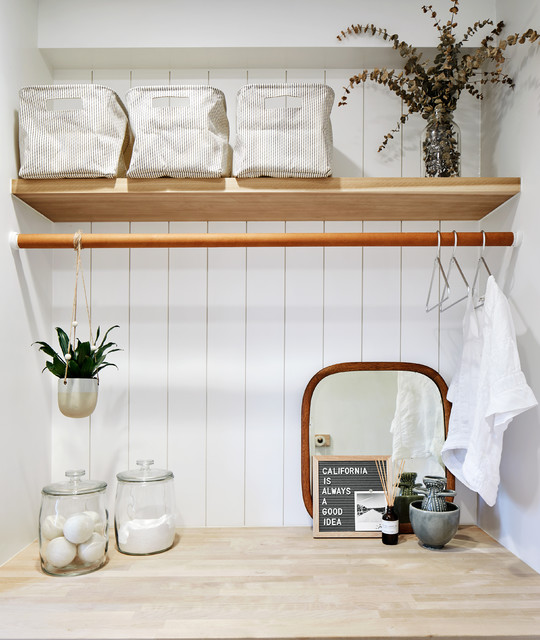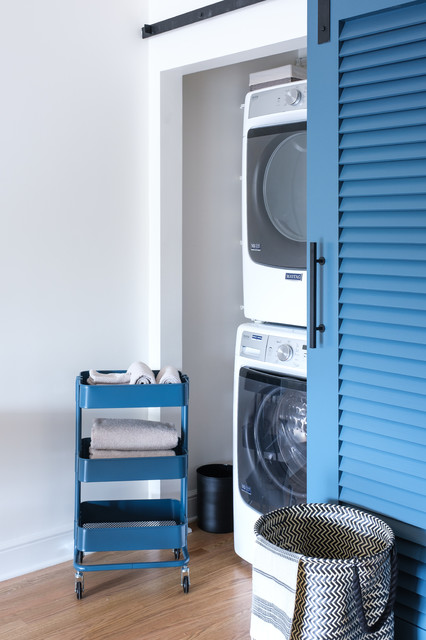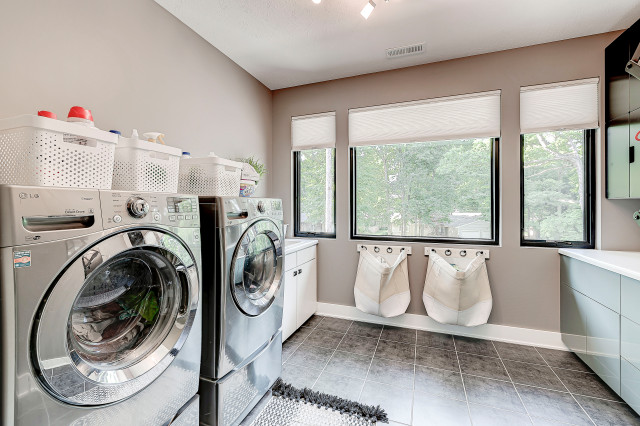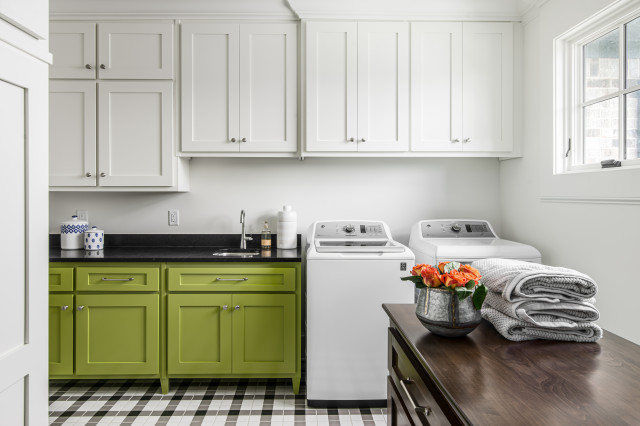How to Organize Your Laundry Room
What to Do Before You Start
Think about your goals. First, assess what your laundry room needs are. Do you plan to use it purely for laundering or will it also serve as storage space for other items? What types of laundry needs — handwashing, baby clothing, delicate items, hang drying — do you have?
Second, what types of non-laundry items would you like to keep in the space? Give these two questions some in-depth thought before you purchase organization products or remodel your laundry room.

Declutter. As with most organizing projects, it’s best to start by paring down unwanted or unused items that are irrelevant to your goals for the space. Whatever you want to store in your laundry room is OK — it doesn’t have to be laundry-related if you have the space.
Once you’ve decided on the items you want to keep in your laundry room, I suggest staying focused on those categories and trying not to let other random items creep into the mix.
I recommend the following general plan for decluttering.
1. Pull aside categories of items you don’t want in your laundry room and find other homes for them. Now would be a good time to recycle, donate or toss unwanted and unused items if you’re able to make those decisions as you pull them out.
Once you’ve decided on the items you want to keep in your laundry room, I suggest staying focused on those categories and trying not to let other random items creep into the mix.
I recommend the following general plan for decluttering.
1. Pull aside categories of items you don’t want in your laundry room and find other homes for them. Now would be a good time to recycle, donate or toss unwanted and unused items if you’re able to make those decisions as you pull them out.
2. Separate remaining items into categories: laundry detergent, fabric softeners, stain removers, cleaning solutions, cleaning rags, ironing supplies, etc. Review each category and consolidate duplicates if possible and toss or donate anything you no longer use. You may discover many items that are no longer relevant if your life stages or routines have changed, such as baby detergent or dog towels.
Also consider the quantity of each category you’re keeping. Is it possible you might not need as much as you currently have? For example, are you keeping gallons of stain remover even though your need for it has decreased significantly? If so, you may want to keep a smaller amount. Or commit to finishing up any excess to slowly free up space for other prime items.
Also consider the quantity of each category you’re keeping. Is it possible you might not need as much as you currently have? For example, are you keeping gallons of stain remover even though your need for it has decreased significantly? If so, you may want to keep a smaller amount. Or commit to finishing up any excess to slowly free up space for other prime items.
3. Review what you have left. These should all be items that you want in your laundry room. Keep them in their categories so you can see how much storage you need for each one before considering storage solutions. Also consider their frequency of use and prioritize the high-use items in the most convenient storage spots.
Basic Improvements
Open shelves. Keep clutter off counters and machine tops with open shelves if cabinets aren’t possible for your project. Consider grouping like items in opaque containers or baskets for a more uniform and tidy appearance. Add labels or hanging tags to identify the general contents of a basket.
For smaller rooms, consider incorporating your laundry necessities as part of your decor. For example, powdered laundry detergent, dryer balls and scent booster beads can be repackaged in decorative glass canisters or apothecary jars and arranged on a countertop, open shelf or machine top. I recommend using airtight canisters for items whose quality may be compromised by moisture or air.
Open shelves. Keep clutter off counters and machine tops with open shelves if cabinets aren’t possible for your project. Consider grouping like items in opaque containers or baskets for a more uniform and tidy appearance. Add labels or hanging tags to identify the general contents of a basket.
For smaller rooms, consider incorporating your laundry necessities as part of your decor. For example, powdered laundry detergent, dryer balls and scent booster beads can be repackaged in decorative glass canisters or apothecary jars and arranged on a countertop, open shelf or machine top. I recommend using airtight canisters for items whose quality may be compromised by moisture or air.
Rolling cart. I often see small gaps next to laundry machines in my clients’ homes. This neglected space might be a hidden storage treasure with the help of a slim rolling cart.
For side-by-side machines, I recommend deciding if you want the cart to go in between the machines or to the side of one of them before you purchase a rolling cart. If your appliances are stacked, it’s usually evident which side will work better for a cart.
For side-by-side machines, I recommend deciding if you want the cart to go in between the machines or to the side of one of them before you purchase a rolling cart. If your appliances are stacked, it’s usually evident which side will work better for a cart.
Baskets or bins. Sometimes the only storage option is on top of the machines. One solution to keep organized is to gather and place all of your most frequently used laundry and relevant cleaning items on a large turntable so each item is equally reachable. If you have many items, opaque bins or baskets can keep the top of your machines looking clean and clutter-free.
If don’t have a great amount of trash needs in your laundry room, you may want to save space and downsize to a small, inconspicuous countertop can.
If don’t have a great amount of trash needs in your laundry room, you may want to save space and downsize to a small, inconspicuous countertop can.
Over-the-door storage. Hanging organizers, drying racks or ironing systems can keep prime functions within reach but out of sight in a small space. Assess whether the function is truly needed before allocating precious space for it.
I have switched to a small steam iron and find myself rarely using a traditional iron, so my iron can be stored in a non-prime spot. A surface with an ironing pad serves my needs, and my large space-hogging ironing board has been donated.
I have switched to a small steam iron and find myself rarely using a traditional iron, so my iron can be stored in a non-prime spot. A surface with an ironing pad serves my needs, and my large space-hogging ironing board has been donated.
Midrange Solutions
Countertop. Installing a counter that spans the entire length of side-by-side units may not only prevent items from falling through any cracks between and behind the machines, but it may also provide your laundry room with a more finished and attractive look.
A continuous surface can be helpful for tasks such as folding items as they come out of the dryer or laying clothes flat to dry. Be sure to select a durable countertop material that won’t warp from moisture and heat.
I recommend working with a contractor to ensure the countertop is installed correctly, allowing enough clearance to be able to move the machines in and out for any repairs.
Countertop. Installing a counter that spans the entire length of side-by-side units may not only prevent items from falling through any cracks between and behind the machines, but it may also provide your laundry room with a more finished and attractive look.
A continuous surface can be helpful for tasks such as folding items as they come out of the dryer or laying clothes flat to dry. Be sure to select a durable countertop material that won’t warp from moisture and heat.
I recommend working with a contractor to ensure the countertop is installed correctly, allowing enough clearance to be able to move the machines in and out for any repairs.
Pedestal bases. To increase storage, consider using pedestal bases with your machines. Check with the manufacturer of your appliances to see if they have storage pedestals that match your model. The potential downside to pedestals is that they may raise the machines to a height that’s too high for folding and sorting.
A compromise may be to have custom-height pedestals made, which will allow for some storage beneath the machines but at a height that accommodates other tasks.
A compromise may be to have custom-height pedestals made, which will allow for some storage beneath the machines but at a height that accommodates other tasks.
Deluxe Improvements
Storage to perfectly suit your needs. If you have the opportunity to remodel your laundry room, you’ll want to consider your preferred setup for your washer and dryer — side by side or stacked (assuming you have front-loading appliances)? If you have the luxury of space, the choice is more about personal preference. If space is limited, the decision may require weighing your priorities.
In a side-by-side situation, you have the option to install a countertop over the two units. Storage cabinets would likely be above the machines, possibly making it harder to access items in the back of the cabinets if the machines are deep.
Storage to perfectly suit your needs. If you have the opportunity to remodel your laundry room, you’ll want to consider your preferred setup for your washer and dryer — side by side or stacked (assuming you have front-loading appliances)? If you have the luxury of space, the choice is more about personal preference. If space is limited, the decision may require weighing your priorities.
In a side-by-side situation, you have the option to install a countertop over the two units. Storage cabinets would likely be above the machines, possibly making it harder to access items in the back of the cabinets if the machines are deep.
I prefer my appliances to be side by side. I’d rather not have to bend down to the washer or reach up to the dryer, especially since it would be less convenient to look into the drum of each machine to ensure I’ve emptied it completely.
However, since I’m not tall, I can’t easily access the storage cabinets above my washer and dryer. I do laundry just once a week but I’d like daily access to the items in the storage cabinets (cleaning products, dusters and sponges). My laundry space is very limited, so I can’t have the best of both worlds.
I’m currently planning to stack my washer and dryer and install some cabinets to the side that will be at an easily accessible height for me. I’m giving up the convenience of having a side-by-side setup at a perfect working height so I can gain easy daily access to the items I use the most. I’ll still be able to have a small counter that would be the same width as the washer I’ll be stacking, as that space will now be free. This setup works best for me because I have decided to prioritize access to the storage cabinets.
However, since I’m not tall, I can’t easily access the storage cabinets above my washer and dryer. I do laundry just once a week but I’d like daily access to the items in the storage cabinets (cleaning products, dusters and sponges). My laundry space is very limited, so I can’t have the best of both worlds.
I’m currently planning to stack my washer and dryer and install some cabinets to the side that will be at an easily accessible height for me. I’m giving up the convenience of having a side-by-side setup at a perfect working height so I can gain easy daily access to the items I use the most. I’ll still be able to have a small counter that would be the same width as the washer I’ll be stacking, as that space will now be free. This setup works best for me because I have decided to prioritize access to the storage cabinets.
Built-in racks. Foldable freestanding drying racks can be a good option, especially if you don’t need to hang-dry clothes often. If air drying is a part of your regular laundry routine, a perpetually open drying rack in the middle of the room could become an eyesore and a physical obstacle.
Instead, consider installing a wall-mounted drying rack that can fold flat against the wall when not in use. Another option is to incorporate a drying rack into your cabinetry, sliding it in and out as needed. A simple closet rod to dry clothes on hangers would also be a solution to keep hang-dried clothing out of the way.
Instead, consider installing a wall-mounted drying rack that can fold flat against the wall when not in use. Another option is to incorporate a drying rack into your cabinetry, sliding it in and out as needed. A simple closet rod to dry clothes on hangers would also be a solution to keep hang-dried clothing out of the way.
Also consider incorporating an ironing board into your cabinets to save space. An ironing board can also be wall-mounted or drawer-mounted.
Sink. A sink requires a lot of room, taking away counter space and storage beneath it. Consider what you may need the sink for and if there’s an alternative (such as a nearby kitchen sink) if you’d rather have the space for other tasks.
If you have a small pet, the laundry room sink may be a good spot for bathing. If you have a larger pet, consider whether it might be worth it to install a larger pet-washing station.
If you have a small pet, the laundry room sink may be a good spot for bathing. If you have a larger pet, consider whether it might be worth it to install a larger pet-washing station.
The time invested in planning and understanding how you use your laundry room can keep it from becoming a catchall space and instead serve as an efficient and focused room that works for you.














Comments
Post a Comment